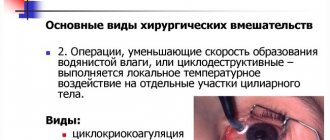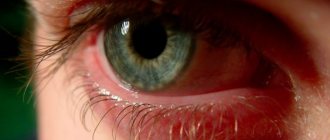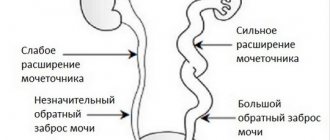Seeing the world in all its colors is a huge gift. Unfortunately, when faced with serious ophthalmological pathologies, some people lose this ability. There are many reasons for the development of eye diseases: infections, heredity, unhealthy lifestyle, injury, etc. The reason for the development of overripe cataracts, leading to blindness, is mainly one - untimely contact with a specialist. Treatment of overripe cataracts is not carried out with the help of medications, so a person with this diagnosis should be prepared for surgical intervention.
Signs
Typical complaints in a patient with mature cataracts may be the following:
- The patient has problems seeing an object: the image doubles and is poorly focused.
- Inability to clearly distinguish an object.
- In the dark, there is a loss of visual contact with objects, reflections and bright glare appear.
- The patient becomes unable to fully distinguish the color shades of objects; colors seem less bright than they really are.
Prevention
Cataract prevention is carried out according to the recommendations of ophthalmologists:
- complete abandonment of all bad habits;
- transition to a balanced menu;
- regular examination by a doctor and timely treatment of ophthalmological diseases;
- use of drops with vitamins - as prescribed by a specialist;
- protection of the organs of vision from ultraviolet radiation with the help of sunglasses.
Compliance with preventive measures and regular preventive examinations by an ophthalmologist will help delay the development of the disease for many years.
Symptoms
The stronger the impact of cataracts, the more pronounced the symptoms become, as well as their number. Over time, the disease manifests itself as follows:
- The patient's visual acuity and ability to respond adequately to light/shadow noticeably decrease.
- Moving spots, dots, and stripes appear before your eyes.
- Objects in the field of view are perceived as blurry and indistinct.
- A feeling of eye fatigue, a “fog” effect, pain and discomfort.
- Uncomfortable sensations when reacting to bright light.
- In the dark, the patient experiences an improvement in the perception of objects, as light begins to pass through the peripheral part of the lens.
- It is possible to restore visual acuity, but after a while, the problem returns.
Cataract stages
A person appreciates good vision precisely when eye diseases begin. The most common are cataracts, which impair the ability of the elastic lens to focus on objects. Its transparency is also lost.
The disease develops gradually, going through several stages. To make it easier for doctors to navigate disorders and prescribe treatment, the following stages were identified:
- Almost mature cataract. There is too little clouding of the lens, mainly from the periphery, but the main part is still transparent and elastic. Gradually, dark stripes develop towards the center of the eye, which begin to interfere with the person, because the view is partially blocked. If the disease develops from the center, then vision loss occurs much faster. Patients may notice spots or floaters in front of their eyes. The first stage can last from a month to 10 years. In this case, the clarity of vision is significantly reduced, and the lens becomes cloudy. To examine an object, a person needs to come very close to it. This period is otherwise called “swelling” due to the fact that the lens enlarges, intraocular pressure increases, and there is a threat of glaucoma.
- Mature cataract. The lens becomes so cloudy that a person can only distinguish large objects and recognize light and shadow. The pupil is the color of milk.
- Overripe. The lens appears yellow. It becomes smaller, due to this it moves in the chamber when the head is tilted. In the substance of the lens, the fibers disintegrate, and a cataract begins to form.
Causes of overripe cataracts
The most important thing that a person diagnosed with cataracts should understand is that delay threatens blindness. Cataracts can be treated, but therapy for the overripe form is more difficult and longer.
The main reasons for the development of this pathology:
- changes associated with the patient's age;
- the presence of concomitant pathologies (endocrine and gastrointestinal diseases);
- heredity;
- received various types of injuries;
- wrong lifestyle;
- uncontrolled use of certain medications.
"Sidorenko's glasses"
For several years now, patients have been interested in modern methods that will make it possible to cure cataracts without surgical intervention. Today there is such a method. This device is “Sidorenko Glasses”. They are an excellent preventative measure that helps improve vision functions. Glasses are also used to favorably influence the external appearance of the eyes.
The device helps strengthen the skin of the eyelids and smooth out small wrinkles. The operating principle of this device is a light vacuum micromassage of the eyes and the skin around them, which improves blood microcirculation and awakens metabolic processes in the eyes and skin areas around them. “Sidorenko glasses” are recommended for use by adults and children over 3 years of age.
This is an innovative device that looks like swimming goggles. The classic glass in this device has been modified with mini-pressure chambers that closely encircle the eye sockets when put on. The healing and health-improving effect is based on the influence of low-intensity cryogenic pressure (spectrum - 0.05-0.1 atm., frequency - 3-4 Hz) on the tissues of the eye and the muscles located near them.
The device helps provide the eye with the necessary nutritional components, restore vision, and improve the condition of the skin of the eyelids and surrounding areas. Already after the first session, it is possible to notice tangible improvements: puffiness decreases, annoying headaches that arise due to visual strain disappear, and the skin in the eye area is significantly smoothed.
Diagnostics
To diagnose cataracts in a patient, medical institutions use proven methods:
- The patient's visual acuity is determined (ranging from normal to almost complete blindness). If the patient's retina is normal, then light perception is properly protected. If a significant decrease in vision is detected, surgery is necessary.
- To exclude the occurrence of glaucoma in a patient, intraocular pressure is determined. Sometimes a tomography is performed.
- Biomicroscopy will help to find out what degree of clouding the lens has and determine where it is localized (it will help with senile cataracts).
- The examination is carried out using transmitted light. In this case, the shadows that move away from the clouded lens are determined using the background of the pink reflex.
- To find out what condition the patient's retina is in, perimetry is performed (the study is especially necessary if the patient has age-related cataracts). The procedure will help diagnose possible complications.
Perimetry is performed to diagnose the retina
- To exclude the occurrence of concomitant pathologies, the fundus of the eye is checked.
When the necessary manipulations are carried out, the specialist will make an accurate diagnosis. If the procedures performed are not enough, additional examinations are prescribed. The patient will have to undergo a blood sugar test and other general clinical examinations. You may also need to consult additional specialists (otolaryngologist, therapist and dentist). This will help to completely exclude concomitant diseases and identify possible contraindications for surgical intervention. These include the presence of severe decompensated diseases and the course of active inflammatory processes in the patient’s body.
Pros of the device
The use of “Sidorenko Glasses” is characterized by a number of positive results:
- Metabolic processes are activated.
- Blood circulation increases.
- The movements of the removal of ophthalmic fluid are activated.
- The formation of nucleoproteins is enhanced.
- Scars are dissolving.
- Protein synthesis is enhanced.
- Tissues are supplied with oxygen.
- The rate of glucose utilization is accelerated.
Pulsed lighting emitted by “Sidorenko Glasses” is capable of generating a reflex enlargement and further reduction of the pupils, which makes it possible to remove spasms of accommodation and increase the power of the accommodative muscle. Uniform muscle contraction activates the nutrition of the eye and eliminates congestion.
“Pankov glasses” how they work
The operation of the device is based on the principles of low-intensity radiation, which can cleanse cells and stimulate microcirculation. Vision functions improve significantly after just a few sessions. In addition, using the device can help improve the general condition of the body, reduce the frequency of headaches, and help normalize sleep.
“Pankov glasses” are recommended for preventive purposes for those whose activities require prolonged exposure to a computer monitor. This mechanism can be used both as a separate treatment technique and as part of a course of therapy.
Tunnel cataract extraction
The presented technology is used if a cloud with a dense core is diagnosed, which is difficult to remove, as well as with age-related mature cataracts. Tunnel extraction belongs to the manual methods of extracting a clouded lens. At the very beginning of the procedure, local anesthesia is administered, after which the specialist receives access to the capsular lobe of the lens and makes a small incision (no more than 3.5 millimeters in length). Then the changed lens is removed from the capsule area.
Instead, an intraocular lens is placed, which helps provide the best refraction of light rays, as well as perform all the standard functions of the lens. There is no need for sutures because the incision made by the doctor is self-sealing.
Tunnel extraction is recognized by experts as one of the more effective methods of treating cataracts. The procedure is characterized by:
- The minimum level of postoperative trauma.
- Low risk of astigmatism (after the procedure).
- A short rehabilitation phase.
Possible complications
The most dangerous complication in advanced stages of the disease is the development of glaucoma. If restoration of vision with overripe cataracts is possible, although partially, then with glaucoma vision is lost irrevocably. Anyone who has been diagnosed with cataract should remember this.
Very often people do not appreciate what they have. The opportunity to see your loved ones and the beauty of the world around you is an incomparable pleasure. Therefore, in order not to feel the truth of “folk” wisdom and not cry over what was lost (including irretrievably), you should contact specialists in a timely manner, lead a correct lifestyle and take care of your health in general.
Drug treatment
For cataracts, the patient is prescribed treatment, which can be medication or surgery. It depends on the degree of damage to the lens. Drug treatment is used in the early stages of the disease. For drug treatment of mature cataracts, drops are prescribed, as well as drugs containing:
- Riboflavin.
- Glutamic acid.
- Cysteine.
- Ascorbic acid;
- Citral.
In addition, medications are prescribed that help improve metabolic processes in the lens. Ophthalmologists prescribe the following drops:
- "Taufon".
- "Ophtan-katachrome."
- Rubistenol.
- Jodocol.
- Perjol.
- Catarstat.
- Opacinan.
- Seletec.
They help slow down the process of lens clouding. The drug "Quinax" helps activate enzymes and promotes the resorption of cloudiness. Patients who have radiation-induced and toxic cataracts can also use drug treatment. However, if the cataract is congenital, then such treatment is not used.
But not at all stages of the disease medications show effective results. Often the only thing that can help the patient is surgery.
With mature cataracts in one eye and good vision in the other, it is better not to rush into surgery, since when removing cataracts in one eye, a significant difference in refraction is obtained. Drug treatment is not a panacea for mature cataracts, but it does help slow down the development process. Additionally, patients are prescribed vitamins and multivitamins, for example, “Undevit”, “Pangexavit”.
Symptoms of cataracts in older people
Deterioration of vision in old age is a common phenomenon, so not everyone can pay attention to alarming symptoms in time. The course of cataracts is gradual, and without timely treatment it leads to blindness, which is where the insidiousness of the pathology manifests itself.
Depending on the degree of maturity, the disease can be of the following types:
- initial cataract (imperceptible or subtle decrease in vision);
- immature (rapid and sharp decline in vision);
- mature cataract (almost complete lack of image clarity);
- overripe (blindness and risk of developing glaucoma).
Glaucoma is a disease that cannot be cured, so if any unpleasant symptoms occur, you should not postpone a visit to an ophthalmologist.
A number of main symptoms that should not be ignored:
- when one eye is closed, the second sees blurredly, and objects appear double;
- glasses do not help improve vision;
- there is increased photosensitivity, glare periodically appears in front of the eyes (mainly in the dark);
- color perception is distorted;
- myopia develops.
Elderly people with cataracts go to the doctor and complain that their glasses are no longer as effective as before and ask to replace them with new ones. Some people notice that they can see much better without glasses than with glasses and mistakenly assume that their vision has improved. Unfortunately, this is not the case, and this is more of a bad sign than a good one.
Surgery
At the stage of mature cataract, surgery is the most effective method. During surgery, the lens is removed and a new lens is installed. Several types of operations are used for this disease:
- Intracapsular extraction.
- Ultrasonic phacoemulsification.
- Laser treatment.
- Extracapsular extraction.
In the first case, the entire lens and capsule are removed. This operation is very difficult and traumatic. In the second case, the lens is brought to an emulsified state and removed from the eye. An artificial lens is inserted in its place. The third method is a technology in which the lens is removed with a laser. These operations are very popular. As for the latter case, the nucleus and mass of the lens without the posterior capsule are removed.
Features of the operation for elderly patients
Patients with overmature cataracts often undergo extracapsular extraction. The essence of the operation is the complete removal of the affected organ (lens) and implantation of a rigid lens (sewn to the iris or attached to the lens capsule). There is a risk of wound dehiscence during the rehabilitation period.
Despite the fact that the likelihood of unpleasant complications occurring is high, it is still necessary to convince an elderly person to undergo surgery. This can be done using the following arguments:
- Cataracts sooner or later lead to blindness, and blindness leads to a feeling of helplessness;
- there are no miraculous potions, and traditional medicine will never be able to cope with the disease, so it is important to understand that it is impossible to cure cataracts without surgery;
- you should not hesitate and doubt, since delay will not improve the situation in any way (the doctor needs to examine the patient, select treatment tactics, and this takes time);
- the operation in this case is quick and painless;
- improved lenses will allow you to see even without glasses, and in old age this is a special plus (of course, if there are no other ophthalmological pathologies).
Elderly people are often afraid to undergo surgery for various reasons, but in this case all possible risks are justified. You just have to trust your loved ones and your doctor.
Features of surgical treatment of mature cataracts
Surgical therapy aims to restore a person's vision. Modern techniques make it possible to minimize the level of traumatic intervention. This is achieved by preserving the lens capsule, creating a small incision, and using specific methods to remove the clouded lens. In addition, one type of operation is the implantation of elastic lenses or intraocular lenses.
The method of extracapsular cataract extraction fully meets these criteria.
Newest method
Perhaps in the near future, a new method of treating cataracts will become widespread - growing the lens inside the eye using stem cells. This technology was developed by molecular biologists in China and the USA.
It is based on the regenerative potential of stem cells, which can be used to restore organs and tissues and treat congenital diseases. If, during surgery to remove the lens, the stem cells present in it are preserved and then their growth is stimulated, the biological lens and vision will be restored.
The technique was tested on rats and rabbits, and then successfully carried out on 12 infants, whose vision was restored within 3 months. As a result, it was found that the use of stem cells is ideal for the treatment of congenital cataracts. Now scientists are working on adapting this technique to eliminate acquired cataracts.











